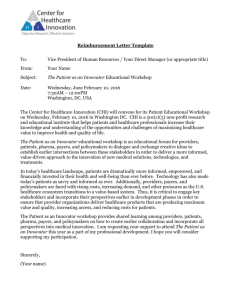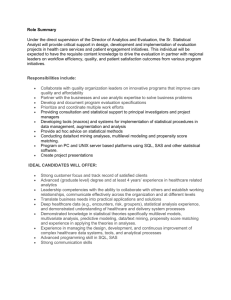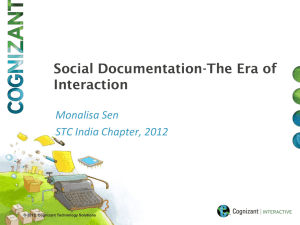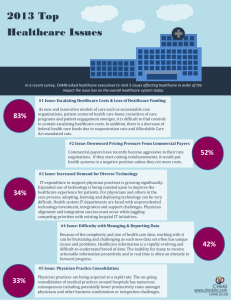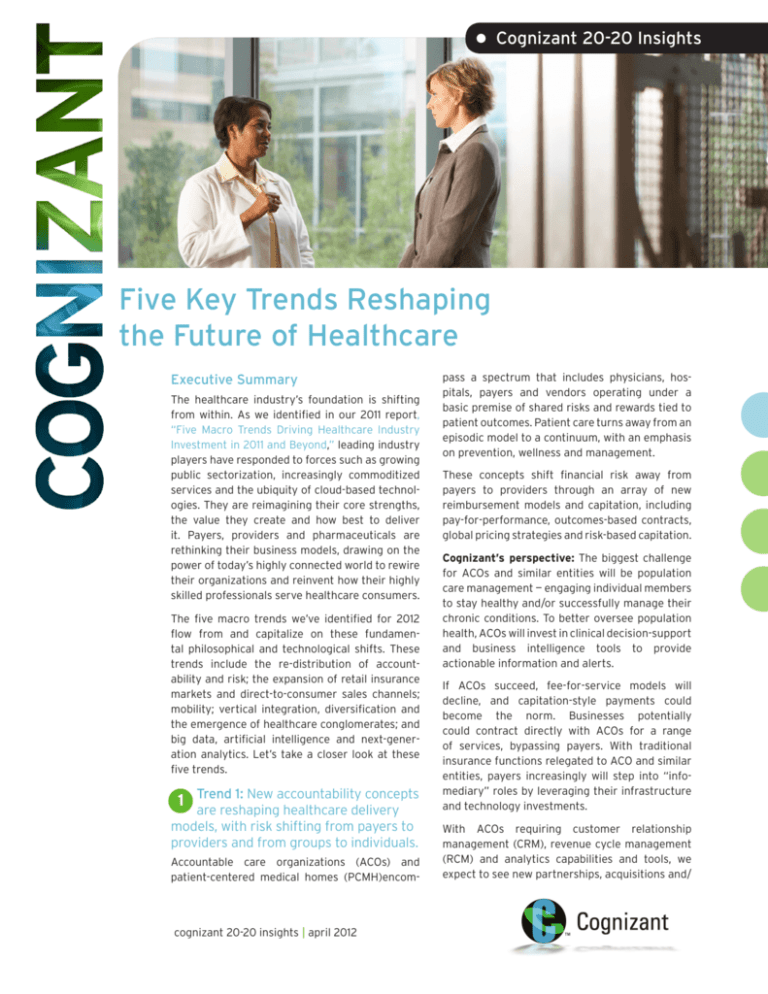
• Cognizant 20-20 Insights
Five Key Trends Reshaping
the Future of Healthcare
Executive Summary
The healthcare industry’s foundation is shifting
from within. As we identified in our 2011 report,
“Five Macro Trends Driving Healthcare Industry
Investment in 2011 and Beyond,” leading industry
players have responded to forces such as growing
public sectorization, increasingly commoditized
services and the ubiquity of cloud-based technologies. They are reimagining their core strengths,
the value they create and how best to deliver
it. Payers, providers and pharmaceuticals are
rethinking their business models, drawing on the
power of today’s highly connected world to rewire
their organizations and reinvent how their highly
skilled professionals serve healthcare consumers.
The five macro trends we’ve identified for 2012
flow from and capitalize on these fundamental philosophical and technological shifts. These
trends include the re-distribution of accountability and risk; the expansion of retail insurance
markets and direct-to-consumer sales channels;
mobility; vertical integration, diversification and
the emergence of healthcare conglomerates; and
big data, artificial intelligence and next-generation analytics. Let’s take a closer look at these
five trends.
pass a spectrum that includes physicians, hospitals, payers and vendors operating under a
basic premise of shared risks and rewards tied to
patient outcomes. Patient care turns away from an
episodic model to a continuum, with an emphasis
on prevention, wellness and management.
These concepts shift financial risk away from
payers to providers through an array of new
reimbursement models and capitation, including
pay-for-performance, outcomes-based contracts,
global pricing strategies and risk-based capitation.
Cognizant’s perspective: The biggest challenge
for ACOs and similar entities will be population
care management — engaging individual members
to stay healthy and/or successfully manage their
chronic conditions. To better oversee population
health, ACOs will invest in clinical decision-support
and business intelligence tools to provide
actionable information and alerts.
1 Trend 1: New accountability concepts
If ACOs succeed, fee-for-service models will
decline, and capitation-style payments could
become the norm. Businesses potentially
could contract directly with ACOs for a range
of services, bypassing payers. With traditional
insurance functions relegated to ACO and similar
entities, payers increasingly will step into “infomediary” roles by leveraging their infrastructure
and technology investments.
Accountable care organizations (ACOs) and
patient-centered medical homes (PCMH)encom-
With ACOs requiring customer relationship
management (CRM), revenue cycle management
(RCM) and analytics capabilities and tools, we
expect to see new partnerships, acquisitions and/
are reshaping healthcare delivery
models, with risk shifting from payers to
providers and from groups to individuals.
cognizant 20-20 insights | april 2012
or mergers among payers and provider organizations by year’s end (see Trend 4). Breaking
barriers among payers, hospitals, physicians and
other players is a positive development for the
industry to deliver quality care at lower costs.
2 Trend 2: Changing channels: Payers
will market directly to consumers,
expanding the retail insurance market
and readying themselves for participating in health benefit
exchanges.
The Affordable Care Act would result in 32 million
more Americans having insurance coverage,
with individual membership increasing from 11
million today to nearly 20 million. If the law is
not overturned by the Supreme Court, marketing
directly to these consumers will
require insurers to make their
To succeed, plans products and services easy for
must invest heavily individuals to understand and
navigate. Payers would also
in designing and need to become sophisticated
implementing new about consumer behaviors and
individual consumer- preferences.
oriented market
segmentation
strategies.
These steps would also be
prerequisites for success in
the American Health Benefit
Exchanges (ABEs) that each
state would be required to
launch by 2014. Underwriting approaches, demographics, regional variations and network availability would likely create wide variations in plan
participation from state to state.
Cognizant’s perspective: Health plans that have
historically focused on the individual market
will be well-positioned to take advantage of the
expected growth in this segment. By 2014, we
expect to see some new — and some nontraditional — players dominating the health benefit
exchange and individual insurance markets.
To succeed, plans must invest heavily in designing
and implementing new individual consumer-oriented market segmentation strategies. Payers will
continue to emulate financial services and insurance industry business models for consumer profiling, market segmentation and 360-degree customer views. Mass customization and personalized
products will proliferate for the individual market.
These will include “build-your-own benefit plan”
approaches in which members can plug-and-play
provider networks, benefit provisions and riders,
modeling premium rates with real-time quotes.
cognizant 20-20 insights
Not surprisingly, creating these features will
require substantial technology investments,
with payers retooling their group-oriented core
platforms to accommodate individual and member-centric products and services, as well as
voluntary benefits.
Payers also should invest in CRM systems to
support new customer service requirements,
while new analytics capabilities will be required to
evaluate product performance. Solution providers
in the “quote to card” and “quote to bill” space will
proliferate, with cloud platform-based business
process outsourcing (BPO) solutions.
3 Trend 3: With an “app for that”
available, all healthcare is not local.
Experiments with “virtual care” models
and telehealth will proliferate and
accelerate throughout 2012 and beyond,
disrupting traditional care models.
Rapidly evolving and increasingly powerful
technologies like mobility, broadband, social
computing, apps, “anything as a service” and
cloud-based service models make it possible to
deliver and receive care anywhere.
Rapidly multiplying mobile health apps collect
and send vital signs from wireless and wired
remote patient and personal health monitoring
devices. More than 9,000 healthcare-related
applications already are available to the public
via smartphone.
Cognizant’s perspective: Cloud technology,
combined with advances in mobility and telepresence solutions, will create new “unwired” business
models capable of providing care anywhere.
That will enable new entrants to leapfrog bricksand-mortar and go directly to virtual integrated
healthcare delivery models.
Mobile and telehealth applications and remote
monitoring devices will dramatically change how
patients and providers interact. Mobility solutions will expand in provider and clinical settings,
and care management strategies will be increasingly dependent on remote monitoring devices
and remote interventions. Network development
strategies will change to accommodate online networks and reimbursement models for e-consults.
On premises, heavily customized CRM and RCM
infrastructure will hamper many institutions from
capitalizing on these trends. Privacy and security
issues will grow alongside the use of mobile
devices and greater consumer connectivity.
2
Cloud computing solutions will be critical to
delivering scalable, reliable and secure mobile
and remote solutions that enable new business
models and a rewired healthcare workforce.
“Virtual ACO” solutions will spread; expect “ACOin-a-box” offerings from IT consultancies and
software houses to address the technology needs
of these new entities. Cloud and various IT-as-aservice models will fundamentally change the
capital expense and operating cost equations
associated with software, services and hardware,
creating opportunities and eliminating barriers
for new entrants to the mobile and virtual health
marketplace.
4 Trend 4: Vertical integration, di-
versification and the emergence of
healthcare conglomerates: With lines of
demarcation among industry sectors
blurring, healthcare players have new
opportunities to work together to
rethink business models to capitalize
on each others’ areas of expertise and
share the risks and rewards of new ways
of delivering care.
Post-healthcare reform strategies will reshape
the healthcare industry landscape. New deals
from traditional players will combine the care
experience of providers, the analytics and
risk management expertise of payers and the
outreach infrastructure of life sciences and
pharmaceuticals. This activity could involve
suppliers buying providers; health plans teaming
with providers; and pharmaceuticals becoming
involved in services along care pathways. Mergers
and acquisitions will increase, with companies
looking for growth, as well as to fill in services
along the continuum of care.
Cognizant’s perspective: Adaptable, agile health
plan business models that can accommodate
accelerated transformation through rapid-cycle
change management, innovation and virtualization will be in the best position to exploit the
business opportunities in a post-reform market.
Business and technical agility will drive sustainability and profitability. In particular, M&A and
integration capabilities will be paramount, with
vertical market M&A activity dominating the
market this year. Payers and other industry stakeholders must be proficient at quickly absorbing
and/or launching lines of business.
More health plans will differentiate themselves
based on the solutions they offer and outcomes
cognizant 20-20 insights
they enable with their technology and applications.
Health plans will grow revenues by offering their
care and disease management, claims processing
and/or business and IT capabilities as services.
Payers also will acquire provider technology
platforms and applications to accelerate vertical
integration. Further, they’ll leverage existing IT
capabilities as revenue drivers in international
markets, as well as at home.
5 Trend 5: Healthcare will begin
unlocking the value in big data,
artificial intelligence and next-generation
health analytics and business intelligence. As the healthcare system
removes structural barriers to data
access and sharing — and puts the
right incentives in place to encourage
the same — tremendous value will
be unleashed.
The digital universe will expand by a magnitude
of 44 in the coming year, with 5.3 billion mobile
subscriptions and millions of apps generating
petabytes and beyond of data.1 Next-generation
analytics tools and artificial intelligence are
being unleashed on these data stores across the
economy.
“Big data” in healthcare could create opportunities in comparative effectiveness research to
develop optimal treatment pathways; medical loss
ratio (MLR) improvement and measurement; and
ACO enablement and management, as well as
clinical decision support systems. Analytics will
also enhance industry stakeholder capabilities for
customer analysis, care and risk
management at the population “Virtual ACO”
level, leading to innovative solutions will spread;
product design. Aggregated
data collections from remote expect “ACO-in-amonitoring of chronically ill box” offerings from
patients should drive significant IT consultancies and
cost and quality value. Enhanced
data will also be useful to the software houses
CMS Innovation Center and the to address the
Independent Payment Advisory technology needs of
board, as they sculpt outcomesthese new entities.
based reimbursement designs.
That said, opportunities for generating clinical
insights, improving care delivery and reducing
costs through big data will depend on how well
healthcare organizations and policy makers deal
with structural, security and privacy barriers to
using data.
3
Cognizant’s perspective: The healthcare market
will start to segment, with organizations capable
of leveraging the power of analytics demonstrating clear advantages in market share and trend
management. Data mining technology today
supports predictive modeling
Greater investment and risk stratification and will
evolving. Plans using
in superior analytics continue
near-real-time data will improve
also will sharply MLR management and offer more
increase the “speed competitively priced products.
to business value” of
ICD-10, meaningful
use and ACOs.
Greater investment in superior
analytics also will sharply increase
the “speed to business value” of
ICD-10, meaningful use and ACOs.
Health plans will make IT investment decisions with
these priorities in mind, keeping them firmly within
the context of broader information management
(IM) strategic road maps that encompass data
management and business intelligence.
Payers must invest in health exchanges to be competitive. To reduce capital expenses and better
manage operating costs, plans will access platform-based, cloud-powered BPO for “on-demand”
analytics and “knowledge as a service” offerings.
Additional and Continuing Trends
In addition to the five major trends for 2012
discussed above, the industry continues to
address the following:
• Integrated
health management focusing on
population health and care management.
• Driving business value from ICD-10 implementation.
• Increasing efficiency and effectiveness across
core processes, including claims, utilization
management, enrollment and billing.
• Globalization
and expansion to international
markets.
The emerging trends for 2012 complement these
ongoing initiatives. Taken together, they indicate
a significant reshaping of healthcare’s landscape
in the coming year. New thinking about business
models and the availability of powerful mobile
and cloud technologies are both driving and
enabling these industry shifts toward differently
wired, streamlined, vertically integrated entities
that are able to deliver care anytime, anywhere,
with higher quality, better outcomes and lower
costs.
Footnote
1
“The World in 2010: ICT Facts and Figures,” International Telecommunication Union, Oct. 20, 2010.
www.itu.int/ITU-D/ict/material/FactsFigures2010.pdf
About the Author
Bill Shea is an Assistant Vice President within Cognizant Business Consulting’s Healthcare Practice.
He has over 20 years of experience in management consulting, practice development and project
management in the health industry across the payer, purchaser and provider markets. Bill has significant experience in health plan strategy and operations in the areas of medical management,
claims management, provider and network management and product development. Prior to joining
Cognizant, he was a Partner in CSC’s Health Plan Practice, a Principal with IBM Global Services
Health Industry Consulting Organization, a Senior Manager with Deloitte & Touche’s Integrated
Health Group, and a Director with the Pacific Business Group on Health. Bill can be reached at
William.Shea@cognizant.com.
About Cognizant
Cognizant (NASDAQ: CTSH) is a leading provider of information technology, consulting, and business process outsourcing services, dedicated to helping the world’s leading companies build stronger businesses. Headquartered in
Teaneck, New Jersey (U.S.), Cognizant combines a passion for client satisfaction, technology innovation, deep industry
and business process expertise, and a global, collaborative workforce that embodies the future of work. With over 50
delivery centers worldwide and approximately 111,000 employees as of March 31, 2011, Cognizant is a member of the
NASDAQ-100, the S&P 500, the Forbes Global 2000, and the Fortune 500 and is ranked among the top performing
and fastest growing companies in the world. Visit us online at www.cognizant.com or follow us on Twitter: Cognizant.
World Headquarters
European Headquarters
India Operations Headquarters
500 Frank W. Burr Blvd.
Teaneck, NJ 07666 USA
Phone: +1 201 801 0233
Fax: +1 201 801 0243
Toll Free: +1 888 937 3277
Email: inquiry@cognizant.com
1 Kingdom Street
Paddington Central
London W2 6BD
Phone: +44 (0) 20 7297 7600
Fax: +44 (0) 20 7121 0102
Email: infouk@cognizant.com
#5/535, Old Mahabalipuram Road
Okkiyam Pettai, Thoraipakkam
Chennai, 600 096 India
Phone: +91 (0) 44 4209 6000
Fax: +91 (0) 44 4209 6060
Email: inquiryindia@cognizant.com
­­© Copyright 2012, Cognizant. All rights reserved. No part of this document may be reproduced, stored in a retrieval system, transmitted in any form or by any
means, electronic, mechanical, photocopying, recording, or otherwise, without the express written permission from Cognizant. The information contained herein is
subject to change without notice. All other trademarks mentioned herein are the property of their respective owners.

